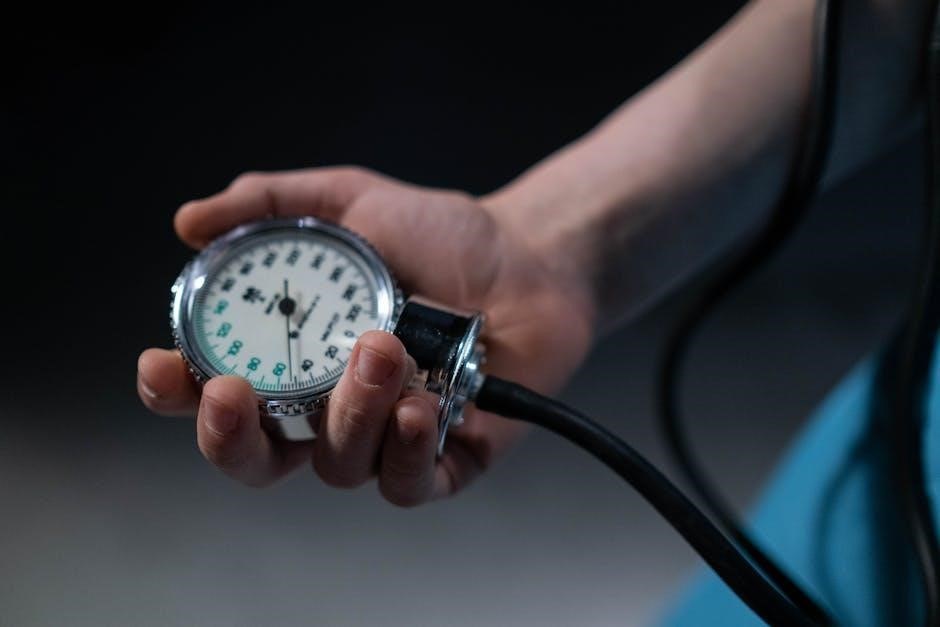Understanding Pulse Oximeter Readings
A pulse oximeter measures oxygen saturation (SpO2) and pulse rate using light beams. It provides crucial insights into blood oxygen levels and heart rate, ensuring accurate health assessments.
1.1 What is a Pulse Oximeter?
A pulse oximeter is a small, non-invasive device that clips onto a finger to measure oxygen saturation (SpO2) and pulse rate. It uses light beams to assess blood oxygen levels and heart rate, providing quick and accurate readings. This portable tool is essential for monitoring respiratory and cardiovascular health, offering insights into overall well-being.
1.2 Key Measurements: SpO2 and Pulse Rate
A pulse oximeter measures two critical values: SpO2 (oxygen saturation) and Pulse Rate. SpO2 indicates the percentage of oxygen in your blood, while Pulse Rate shows your heart rate per minute. These measurements are vital for assessing respiratory and cardiovascular health, helping identify potential issues like low oxygen levels or irregular heartbeats. Accurate readings ensure proper monitoring and timely medical interventions.
Normal Pulse Oximeter Readings
Normal SpO2 levels range from 95% to 100%, while pulse rates typically fall between 60 to 100 beats per minute for healthy adults.
2.1 Normal SpO2 Levels
Normal SpO2 levels typically range from 95% to 100%, indicating healthy oxygen saturation in the blood. These levels are essential for proper bodily functions and overall well-being. Maintaining SpO2 within this range ensures adequate oxygen delivery to tissues and organs, supporting optimal health. Monitoring these levels regularly can help identify potential respiratory or circulatory issues early.
2.2 Normal Pulse Rate Range
A normal pulse rate for adults typically ranges from 60 to 100 beats per minute (BPM). This range varies based on age, fitness level, and overall health. For instance, athletes may have a lower resting heart rate, while infants often have higher rates; Monitoring pulse rate alongside SpO2 levels helps assess cardiovascular health and detect potential irregularities early.
2.3 Importance of Normal Readings
Normal pulse oximeter readings indicate healthy oxygen saturation and pulse rate levels, which are essential for proper bodily functions. Maintaining normal SpO2 and pulse rate ensures optimal oxygen delivery to organs and tissues, supporting overall well-being. Early detection of abnormal readings allows for timely medical intervention, preventing potential complications. Monitoring these values is crucial, especially for individuals with chronic respiratory or cardiovascular conditions.

How to Use a Pulse Oximeter
Turn on the device, place it on your finger, and wait for the readings. Ensure proper fit and avoid movement for accurate SpO2 and pulse rate measurements.
3.1 Steps to Take Readings
To take accurate readings, turn on the pulse oximeter and gently place it on your finger. Ensure the sensor is properly aligned and avoid movement. Wait for the device to display stable SpO2 and pulse rate values. Avoid wearing nail polish or tight clothing that may interfere with light transmission. Record the readings in your chart for future reference and monitoring.
3.2 Ensuring Accuracy in Measurements
For accurate readings, ensure proper finger placement and avoid movement. Remove nail polish and keep hands warm to improve blood flow. Position the oximeter correctly, avoiding tight clothing that restricts circulation. Use the device in a well-lit area and wait for stable readings before recording. Regularly check the device’s calibration and follow manufacturer guidelines to maintain reliability and precision in your measurements.

Creating a Pulse Oximeter Readings Chart
A readings chart helps track SpO2 and pulse rate over time, enabling better health monitoring and trend identification. Include date, time, and readings, and use a PDF template for organization and clarity.
4.1 Why Keep a Readings Chart?
Keeping a pulse oximeter readings chart helps monitor your health by tracking SpO2 and pulse rate. Regularly recording data allows you to identify trends and detect changes early. This tool is especially useful for those with chronic conditions, enabling better management and informed decisions. Sharing the chart with healthcare providers ensures comprehensive care and tailored advice.
4.2 How to Record Your Data
To effectively record pulse oximeter readings, start by obtaining a pulse oximeter readings chart PDF. This chart typically includes columns for date, time, SpO2 level, pulse rate, and additional notes. Consistency is key; take readings at the same times daily, such as morning and evening. Note any physical activities or health statuses that might influence readings, like exercise or symptoms. Ensure accuracy by keeping your finger clean and dry, and verify questionable readings with a second measurement. For organization, consider digital apps that sync with your oximeter for automatic logging, while maintaining a physical backup for redundancy; Organize data chronologically, using separate sections for each day or week, and consider highlighting trends or anomalies. When sharing with healthcare providers, summarize key points to facilitate quick understanding. Prioritize privacy by using secure digital storage or safekeeping physical records. By establishing a routine and organized system, you can track health trends effectively and make informed decisions.
4.3 Sample PDF Chart Template
A sample PDF chart template for pulse oximeter readings typically includes columns for date, time, SpO2, pulse rate, and notes. It may feature a clean layout with clear headers, rows for daily entries, and instructions for use. Some templates offer sections for patient information and graphs to visualize trends. The chart is designed to be user-friendly, ensuring consistent and organized tracking of health data over time.

Factors Affecting Pulse Oximeter Readings
Physical conditions like poor circulation, environmental factors such as cold temperatures, and device-related issues like sensor misalignment can influence pulse oximeter readings, affecting accuracy and reliability.
5.1 Physical Conditions Impacting Readings
Physical conditions like poor circulation, cold hands, or hypoperfusion can affect pulse oximeter readings. Chronic illnesses such as COPD or anemia may also alter SpO2 levels. Additionally, skin pigmentation or nail polish can interfere with light absorption, potentially causing inaccurate results. These factors highlight the importance of considering individual health conditions when interpreting readings.
5.2 Environmental Factors
Environmental factors such as bright lighting, extreme temperatures, or device positioning can impact pulse oximeter accuracy. Movement or shivering may cause unstable readings, while cold hands can reduce blood flow, affecting SpO2 levels. Ensuring a stable and calm environment is crucial for obtaining reliable measurements, as external conditions can interfere with light absorption and sensor functionality.
5.3 Device-Related Issues
Device-related issues, such as poor probe fit, sensor malfunctions, or calibration errors, can affect pulse oximeter readings. Incorrect finger size, nail polish, or excessive motion may interfere with light absorption, leading to inaccurate SpO2 or pulse rate measurements. Ensuring proper device functioning and regular checks is essential for reliable results and accurate tracking in your readings chart.
When to Seek Medical Advice
Consult a doctor if your SpO2 drops below 88% or if you experience symptoms like shortness of breath, chest pain, or severe coughing, even with normal readings.
6.1 Low SpO2 Levels
If your blood oxygen saturation (SpO2) falls below 88% consistently, it may indicate a serious issue. Seek medical advice, especially if accompanied by symptoms like shortness of breath or chest pain. For individuals with chronic lung conditions, such as COPD, lower baseline levels are common, but significant drops still warrant concern. Always monitor and consult a healthcare professional if readings remain low or worsen over time.
6.2 High or Irregular Pulse Rate
A pulse rate above 100 BPM for adults is considered high and may indicate stress, anxiety, or underlying health issues. Irregular heartbeats, such as arrhythmias, can also appear on pulse oximeter readings. If your pulse rate remains elevated or irregular, consult a healthcare professional, especially if accompanied by symptoms like dizziness or chest discomfort. Monitoring and medical evaluation are crucial in such cases.
6.3 Fluctuating Readings
Fluctuating pulse oximeter readings, such as varying SpO2 or pulse rate values, may indicate issues like poor circulation, movement, or device malfunctions. If readings frequently change, ensure proper sensor placement and avoid moving during measurements. Persistent fluctuations warrant medical consultation, as they may signal underlying health concerns. Recording these variations in your chart can help track patterns and guide further evaluation.

Tips for Accurate Readings
Ensure proper finger placement, avoid movement, and maintain good blood flow. Use the chart to track consistency and identify patterns for reliable pulse oximeter measurements.
7.1 Preparing for Measurement
Before using a pulse oximeter, ensure your hands are warm and dry. Avoid nail polish and tight clothing that may restrict blood flow. Sit comfortably, remain still, and avoid movement during measurement. Ensure the device is properly positioned on your finger. Consult a healthcare provider for specific preparation guidance. Using a readings chart can help track consistency and accuracy over time.
7.2 Proper Device Positioning
Place the pulse oximeter on the fingertip, ensuring it fits snugly without restricting blood flow. Avoid placing it over nail polish or jewelry. Keep your hand steady and avoid movement during measurement. Position the sensor so the light beams pass through the fingertip accurately. Proper positioning ensures reliable readings, essential for maintaining an accurate pulse oximeter readings chart and monitoring health effectively.
7.3 Troubleshooting Common Issues
Common issues with pulse oximeter readings include poor finger placement, nail polish interference, or cold hands. Ensure proper positioning, avoid obstructions, and warm hands if necessary. Movement during measurement can cause inaccuracies, so remain still. If readings fluctuate, check device calibration or consult a healthcare professional for assistance. Addressing these issues ensures accurate data for your pulse oximeter readings chart and reliable health monitoring.
Regular monitoring with a pulse oximeter ensures timely health insights, helping you maintain optimal oxygen levels and heart rate for overall well-being and informed medical decisions.
8.1 Key Takeaways
A pulse oximeter readings chart helps track oxygen saturation (SpO2) and pulse rate over time, ensuring consistent monitoring of respiratory health. Healthy SpO2 levels typically range from 95-100%, with lower readings potentially indicating issues like hypoxemia. Regular monitoring is especially vital for individuals with chronic conditions such as COPD. Keeping a detailed chart allows for early detection of changes and informed decisions regarding medical care.
8.2 Importance of Regular Monitoring
Regular monitoring of pulse oximeter readings ensures early detection of changes in oxygen saturation and pulse rate, helping to manage chronic conditions like COPD effectively. Tracking trends over time provides valuable insights for healthcare providers, enabling timely interventions and personalized treatment plans; Consistent monitoring also empowers individuals to take proactive steps toward maintaining optimal respiratory health and overall well-being.
